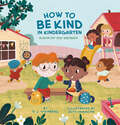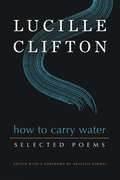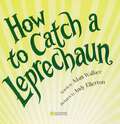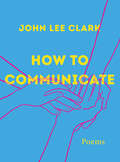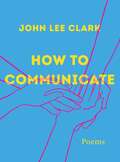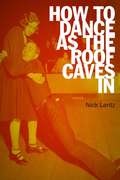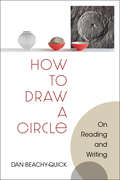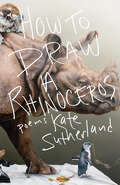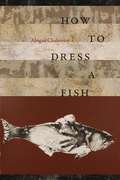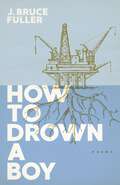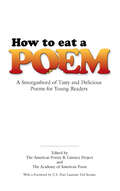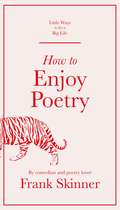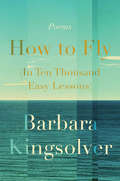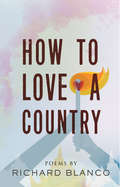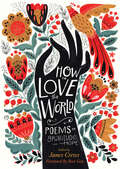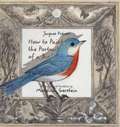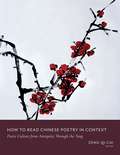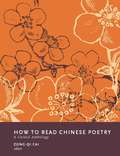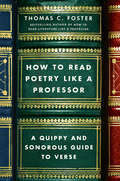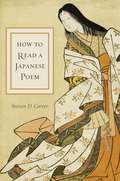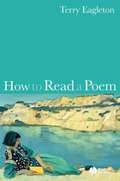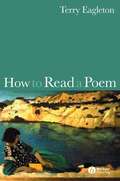- Table View
- List View
How to Be Happy Though Human: New and Selected Poems
by Kate CampA timely collection of new and previously published work by one of New Zealand’s most acclaimed poets, How to Be Happy Though Human introduces Kate Camp’s eclectic and musical poetry to international audiences for the first time.How to Be Happy Though Human: New and Selected Poems is Kate Camp’s seventh book of poetry and the first to be published outside New Zealand. Incorporating a grouping of new, previously unpublished work and a selection of important poems from her six earlier collections, this volume introduces North American readers to poetry that has been described by critics as “fearless,” “mesmerizing,” and “containing a surprising radicalism and power.”Camp’s work is recognized for its wide-ranging and eclectic subject matter, its technical control, and its musicality, with pop culture, high culture, the domestic confessional, close observation, and found language featured as recurring elements of style.A timely retrospective that represents a new chapter in Camp’s career, How to Be Happy Though Human promises to gain a wide readership for this thoughtful, engaging, and popular writer.
How to Be Kind in Kindergarten: A Book for Your Backpack
by D.J. SteinbergFrom the best-selling author of the hugely popular Kindergarten, Here I Come!, here's a guidebook in verse that shows children how to be kind in the new and exciting world of kindergarten.Small enough to fit in a child's backpack, this collection of short poems--one to a page--spans the entire year of kindergarten, offering sweet and simple tips on how to be your best self--sharing your umbrella with a friend; taking turns on the swings, and inviting someone to join in a game. This is the perfect companion to DJ Steinberg's enormously successful Kindergarten, Here I Come!
How to Be a Good Girl: A Miscellany
by Jamie HoodThe ambitious and experimental debut by Jamie Hood, author of Trauma Plot, interrogating the &“good girl&” archetype and the price one pays to embody itIn the thick of winter 2020, when so many books were buried beneath the catastrophe of the COVID-19 news cycle, one unlikely debut seemed to cut through the noise. Jamie Hood&’s How to Be a Good Girl was an inventive and hybrid work of self-making, mingling diary entries, poetry, literary criticism, and love letters to interrogate the archetype of the &“good girl,&” and the ideas of femininity, passivity, desire, and trauma that come with it. Journeying from the ice age to our modern-day climate crisis, it devoured texts as expansive as Levinas and Plath to the Ronettes and after-school specials, all the while asking: what pound of flesh must a woman pay to be seen as &“good.&”How to Be a Good Girl was a critical darling when it was first published by Grieveland. The Rumpus praised its &“bold vulnerability,&” and Vogue named it a Best Book of 2020. Now, Vintage is proud to reissue this provocative and genre-bending debut and find new readers for an exciting, new literary voice.
How to Carry Water: Selected Poems Of Lucille Clifton (American Poets Continuum Series #180)
by Lucille CliftonSelected Poems Of Lucille Clifton
How to Catch a Leprechaun (How To Catch Ser.)
by Adam WallaceYou've been planning night and day, and finally you've created the perfect trap with shamrocks, pots of gold, and rainbows galore! Now all you need to do is wait. Is this the year you'll finally catch the leprechaun? Start a St. Patrick's Day tradition with this fun and lively children's picture book and get inspired to build leprechaun traps of your own at home or in the classroom! Laugh along in this zany story for kids that blends STEAM concepts with hilarious rhymes and vibrant illustrations!
How to Communicate: Poems
by John Lee ClarkA stunning debut from an award-winning DeafBlind poet, “How to Communicate is a masterpiece” (Kaveh Akbar). Formally restless and relentlessly instructive, How to Communicate is a dynamic journey through language, community, and the unfolding of an identity. Poet John Lee Clark pivots from inventive forms inspired by the Braille slate to sensuous prose poems to incisive erasures that find new narratives in nineteenth-century poetry. Calling out the limitations of the literary canon, Clark includes pathbreaking translations from American Sign Language and Protactile, a language built on touch. How to Communicate embraces new linguistic possibilities that emanate from Clark’s unique perspective and his connection to an expanding, inclusive activist community. Amid the astonishing task of constructing a new canon, the poet reveals a radically commonplace life. He explores grief and the vagaries of family, celebrates the small delights of knitting and visiting a museum, and, once, encounters a ghost in a gas station. Counteracting the assumptions of the sighted and hearing world with humor and grace, Clark finds beauty in the revelations of communicating through touch: “All things living and dead cry out to me / when I touch them.” A rare work of transformation and necessary discovery, How to Communicate is a brilliant debut that insists on the power of poetry.
How to Communicate: Poems
by John Lee ClarkIn this collection of poems John Lee Clark writes from the inside about the experience of deafblindness. Poems share the richness and intimacy of tactile communication, the hilarity of errors in Sign as used by the hearing, and the complexity of relationships. Several poems explore the lives of historic blind and deafblind figures. Many of these poems were previously published in such literary journals as American Poetry Review, The Paris Review, and Poetry.
How to Dance as the Roof Caves In: Poems
by Nick LantzIn these poems the author examines America as it faces a recession of collective mood and collective wealth and describes the changing American landscape with great imagination and sharp wit.
How to Draw a Circle: On Reading and Writing (Poets On Poetry)
by Dan Beachy-QuickWhat is it to write a poem? What work do words do when placed with care and vision into the intensely charged space of poetic effort? How to Draw a Circle does not seek to answer those questions, but to encounter them as fully and honestly as one can. The thread running through the essays is an ongoing investigation into poetry as an epistemological experiment, one which binds the imagination to the worldly, and trusts that creative endeavor is a form of participation in the ongoing creation of the world. It does so in part by focusing on thinkers, poets, writers, and literary movements where such thinking for a while prevailed, from Socrates to Melville, Mythology to Romanticism. Here the poem is approached as something deeply rooted in human consciousness, done so not to make an atavistic claim about poetry's history, but to show the ways in which oldest tradition gives us ever-new eyes. The hope this book gathers around is that poetry—poetic expression, the wild wonder of working in words—turns us back toward the world in more vibrant, more open, more ethical ways. How to Draw a Circle summons lyric powers—not an argument, but a participation in the ways poetry works in us and on us.
How to Draw a Rhinoceros
by Kate SutherlandHow to Draw a Rhinoceros, the first book of poems by Canadian writer, scholar, and lawyer Kate Sutherland, mines centuries of rhinoceros representations in art and literature to document the history of European and North American encounters with the animal--from the elephant-rhinoceros battles staged by monarchs in the Middle Ages; the rhinomania that took hold in response to the European travels of Clara the 'Dutch' Rhinoceros in the mid-1700s; the menageries and circuses of the Victorian era; the exploits of celebrated twentieth-century hunters like Teddy Roosevelt and Ernest Hemingway; and the trade in rhinoceros horn artefacts that thrives online today. Along the way, it explores themes of colonialism, animal welfare, and conservation, combining Robert Kroetschian documentary poetics with the meticulous research and environmental passion of Elizabeth Kolbert, to successfully examine the centuries-long path of the rhinoceros that's brought it to the brink of global extinction.Readers of contemporary poetry, as well as those interested in natural history, animal welfare, and conservation, and people who have followed Sutherland's scholarly and literary careers, will relish the rich detail and odd tales of historical rhinoceroses and the people who have kept, shown, and traded in them, as depicted using a range of poetic techniques that only a critical eye like Sutherland's could deliver.
How to Dress a Fish
by Abigal ChabitnoyIn How to Dress a Fish, poet Abigail Chabitnoy, of Aleut descent, addresses the lives disrupted by US Indian boarding school policy. She pays particular attention to the life story of her great grandfather, Michael, who was taken from the Baptist Orphanage, Wood Island, Alaska, and sent to Carlisle Indian Industrial School in Pennsylvania. <P><P> Incorporating extracts from Michael's boarding school records and early Russian ethnologies—while engaging Alutiiq language, storytelling motifs, and traditional practices—the poems form an act of witness and reclamation. <P><P>In uncovering her own family records, Chabitnoy works against the attempted erasure, finding that while legislation such as the Alaska Native Claims Settlement Act reconnects her to community, through blood and paper, it could not restore the personal relationships that had already been severed.
How to Drown a Boy: Poems
by J. Bruce FullerHow to Drown a Boy, a debut collection of poems by J. Bruce Fuller, investigates how boyhood and fatherhood entwine to create cycles that mimic decaying and dangerous natural surroundings. The woods, the water, the oil rigs, and the men who work them all have a powerful effect on the speaker from childhood through adulthood. These poems examine the weight of family and culture against a backdrop of climate change and environmental disaster.
How to Eat a Poem: A Smorgasbord of Tasty and Delicious Poems for Young Readers (Dover Children's Classics)
by Ted Kooser American Poetry & Literacy Project Academy of American PoetsFocusing on popular verse from the nineteenth century through today, this anthology invites young readers to sample a taste of irresistible poems that will nourish their minds and spirits. Selected for both popularity and literary quality, seventy charming poems cover a wide range of subjects: poetry, books, words, and imagination; the beauty of the natural world; travel, adventure, sports, and play; love, friendship, sadness, hope, and other emotions. Included are:"Prickled Pickles Don't Smile," Nikki Giovanni"W. D., Don't Fear that Animal," W. D. Snodgrass"A Jelly-Fish," Marianne Moore"The Porcupine," Ogden Nash"Annabel Lee," Edgar Allan Poe"The Falling Star," Sara Teasdale"Sick," Shel Silverstein"Casey at the Bat," Ernest Lawrence Thayer"With Kitty, Age Seven, At the Beach," William Stafford"Hope is the Thing with Feathers," Emily Dickinson. . . . and sixty other notable works.Chosen by the American Poetry & Literacy Project and the Academy of American Poets, two of the nation's most respected nonprofit poetry organizations, these much-loved and highly readable poems promise young readers and poetry lovers of all ages hours of reading pleasure. Includes 2 selections from the Common Core State Standards Initiative: "Casey at the Bat" and "Oranges."
How to Enjoy Poetry
by Frank Skinner'Someone recently said to me, in reference to my poetry podcast, that you'd think poetry would be more popular than ever, in the twenty-first century, because people don't have a lot of time and 'novels are often quite big while poems are often quite small'. I referred them to Doctor Who's Tardis.'Frank Skinner wants you to read more poetry. Wait, wait - don't stop reading. Whether you're a frequent poetry reader or haven't read any since sixth form, Frank's infectious passion for language, rhythm and metre will win you over and provide you with the basic tools you need to tackle any poem.In this short, easy-to-digest and delightful book, Frank guides us through the twists and turns of 'Pad, pad' by Stevie Smith, a short, seemingly simple poem that contains multitudes of meaning and a deceptive depth of emotion. Revel in the mastery of Stevie Smith's choice of words, consider the eternal mystery of the speaker of the poem and be moved by rhyming couplets like you never have before.Give it a go. You never know, you might even enjoy it.
How to Enjoy Poetry (Little Ways to Live a Big Life #12)
by Frank Skinner'Someone recently said to me, in reference to my poetry podcast, that you'd think poetry would be more popular than ever, in the twenty-first century, because people don't have a lot of time and 'novels are often quite big while poems are often quite small'. I referred them to Doctor Who's Tardis.'Frank Skinner wants you to read more poetry. Wait, wait - don't stop reading. Whether you're a frequent poetry reader or haven't read any since sixth form, Frank's infectious passion for language, rhythm and metre will win you over and provide you with the basic tools you need to tackle any poem.In this short, easy-to-digest and delightful book, Frank guides us through the twists and turns of 'Pad, pad' by Stevie Smith, a short, seemingly simple poem that contains multitudes of meaning and a deceptive depth of emotion. Revel in the mastery of Stevie Smith's choice of words, consider the eternal mystery of the speaker of the poem and be moved by rhyming couplets like you never have before.Give it a go. You never know, you might even enjoy it.
How to Fly (In Ten Thousand Easy Lessons): Poetry
by Barbara KingsolverIn this intimate collection, the beloved author of The Poisonwood Bible and more than a dozen other New York Times bestsellers, winner or finalist for the Pulitzer and countless other prizes, now trains her eye on the everyday and the metaphysical in poems that are smartly crafted, emotionally rich, and luminous. In her second poetry collection, Barbara Kingsolver offers reflections on the practical, the spiritual, and the wild. She begins with “how to” poems addressing everyday matters such as being hopeful, married, divorced; shearing a sheep; praying to unreliable gods; doing nothing at all; and of course, flying. Next come rafts of poems about making peace (or not) with the complicated bonds of friendship and family, and making peace (or not) with death, in the many ways it finds us. Some poems reflect on the redemptive powers of art and poetry itself; others consider where everything begins.Closing the book are poems that celebrate natural wonders—birdsong and ghost-flowers, ruthless ants, clever shellfish, coral reefs, deadly deserts, and thousand-year-old beech trees—all speaking to the daring project of belonging to an untamed world beyond ourselves.Altogether, these are poems about transcendence: finding breath and lightness in life and the everyday acts of living. It’s all terribly easy and, as the title suggests, not entirely possible. Or at least, it is never quite finished.
How to Love a Country: Poems
by Richard BlancoA new collection from the renowned inaugural poet exploring immigration, gun violence, racism, LGBTQ issues, and more, in accessible and emotive versesAs presidential inaugural poet, memoirist, public speaker, educator, and advocate, Richard Blanco has crisscrossed the nation inviting communities to connect to the heart of human experience and our shared identity as a country. In this new collection of poems, his first in over seven years, Blanco continues to invite a conversation with all Americans. Through an oracular yet intimate and accessible voice, he addresses the complexities and contradictions of our nationhood and the unresolved sociopolitical matters that affect us all.The poems form a mosaic of seemingly varied topics: the Pulse Nightclub massacre; an unexpected encounter on a visit to Cuba; the forced exile of 8,500 Navajos in 1868; a lynching in Alabama; the arrival of a young Chinese woman at Angel Island in 1938; the incarceration of a gifted writer; and the poet’s abiding love for his partner, who he is finally allowed to wed as a gay man. But despite each poem’s unique concern or occasion, all are fundamentally struggling with the overwhelming question of how to love this country.Seeking answers, Blanco digs deep into the very marrow of our nation through poems that interrogate our past and present, grieve our injustices, and note our flaws, but also remember to celebrate our ideals and cling to our hopes. In the landmark poem “American Wandersong,” which forms the center of the book, the poet reveals himself to readers in a disarming and kinetic sequence of stanzas, striving to find his place amid the physical and emotional landscapes of our country.Through this groundbreaking volume, Blanco unravels the very fabric of the American narrative and pursues a resolution to the inherent contradiction of our nation’s psyche and mandate: e pluribus unum (out of many, one). Charged with the utopian idea that no single narrative is more important than another, this book asserts that America could and ought someday to be a country where all narratives converge into one, a country we can all be proud to love and where we can all truly thrive.
How to Love the World: Poems of Gratitude and Hope
by James CrewsWhat the world needs now – featuring poems from inaugural poet Amanda Gorman, Ross Gay, Tracy K. Smith and more. More and more people are turning to poetry as an antidote to divisiveness, negativity, anxiety, and the frenetic pace of life. How to Love the World: Poems of Gratitude and Hope offers readers uplifting, deeply felt, and relatable poems by well-known poets from all walks of life and all parts of the US, including inaugural poet Amanda Gorman, Joy Harjo, Naomi Shihab Nye, Ross Gay, Tracy K. Smith, and others. The work of these poets captures the beauty, pleasure, and connection readers hunger for. How to Love the World, which contains new works by Ted Kooser, Mark Nepo, and Jane Hirshfield, invites readers to use poetry as part of their daily gratitude practice to uncover the simple gifts of abundance and joy to be found everywhere. With pauses for stillness and invitations for writing and reflection throughout, as well as reading group questions and topics for discussion in the back, this book can be used to facilitate discussion in a classroom or in any group setting. This publication conforms to the EPUB Accessibility specification at WCAG 2.0 Level AA.
How to Paint the Portrait of a Bird
by Mordicai Gerstein Jacques PrévertHow do you paint a portrait of a bird? First you paint a cage with an open door, then you wait for the bird to come. If it comes, you erase the cage and paint in a beautiful tree, and wait to see if the bird will sing.
How to Read Chinese Poetry in Context: Poetic Culture from Antiquity Through the Tang (How to Read Chinese Literature)
by Edited by Zong-Qi CaiHow to Read Chinese Poetry in Context is an introduction to the golden age of Chinese poetry, spanning the earliest times through the Tang dynasty (618–907). It aims to break down barriers—between language and culture, poetry and history—that have stood in the way of teaching and learning Chinese poetry. Not only a primer in early Chinese poetry, the volume demonstrates the unique and central role of poetry in the making of Chinese culture. Each chapter focuses on a specific theme to show the interplay between poetry and the world. Readers discover the key role that poetry played in Chinese diplomacy, court politics, empire building, and institutionalized learning; as well as how poems shed light on gender and women’s status, war and knight-errantry, Daoist and Buddhist traditions, and more. The chapters also show how people of different social classes used poetry as a means of gaining entry into officialdom, creating self-identity, fostering friendship, and airing grievances. The volume includes historical vignettes and anecdotes that contextualize individual poems, investigating how some featured texts subvert and challenge the grand narratives of Chinese history. Presenting poems in Chinese along with English translations and commentary, How to Read Chinese Poetry in Context unites teaching poetry with the social circumstances surrounding its creation, making it a pioneering and versatile text for the study of Chinese language, literature, history, and culture.
How to Read Chinese Poetry: A Guided Anthology (How to Read Chinese Literature)
by Zong-Qi CaiIn this "guided" anthology, experts lead students through the major genres and eras of Chinese poetry from antiquity to the modern time. The volume is divided into 6 chronological sections and features more than 140 examples of the best shi, sao, fu, ci, and qu poems. A comprehensive introduction and extensive thematic table of contents highlight the thematic, formal, and prosodic features of Chinese poetry, and each chapter is written by a scholar who specializes in a particular period or genre. Poems are presented in Chinese and English and are accompanied by a tone-marked romanized version, an explanation of Chinese linguistic and poetic conventions, and recommended reading strategies. Sound recordings of the poems are available online free of charge. These unique features facilitate an intense engagement with Chinese poetical texts and help the reader derive aesthetic pleasure and insight from these works as one could from the original. The companion volume How to Read Chinese Poetry Workbook presents 100 famous poems (56 are new selections) in Chinese, English, and romanization, accompanied by prose translation, textual notes, commentaries, and recordings.Contributors: Robert Ashmore (Univ. of California, Berkeley); Zong-qi Cai; Charles Egan (San Francisco State); Ronald Egan (Univ. of California, Santa Barbara); Grace Fong (McGill); David R. Knechtges (Univ. of Washington); Xinda Lian (Denison); Shuen-fu Lin (Univ. of Michigan); William H. Nienhauser Jr. (Univ. of Wisconsin); Maija Bell Samei; Jui-lung Su (National Univ. of Singapore); Wendy Swartz (Columbia); Xiaofei Tian (Harvard); Paula Varsano (Univ. of California, Berkeley); Fusheng Wu (Univ. of Utah)
How to Read Poetry Like a Professor: A Quippy and Sonorous Guide to Verse
by Thomas C FosterFrom the bestselling author of How to Read Literature Like a Professor comes this essential primer to reading poetry like a professor that unlocks the keys to enjoying works from Lord Byron to the Beatles.No literary form is as admired and feared as poetry. Admired for its lengthy pedigree—a line of poets extending back to a time before recorded history—and a ubiquitous presence in virtually all cultures, poetry is also revered for its great beauty and the powerful emotions it evokes. But the form has also instilled trepidation in its many admirers mainly because of a lack of familiarity and knowledge. Poetry demands more from readers—intellectually, emotionally, and spiritually—than other literary forms. Most of us started out loving poetry because it filled our beloved children's books from Dr. Seuss to Robert Louis Stevenson. Eventually, our reading shifted to prose and later when we encountered poetry again, we had no recent experience to make it feel familiar. But reading poetry doesn’t need to be so overwhelming. In an entertaining and engaging voice, Thomas C. Foster shows readers how to overcome their fear of poetry and learn to enjoy it once more. From classic poets such as Shakespeare, Samuel Taylor Coleridge, and Edna St. Vincent Millay to later poets such as E.E. Cummings, Billy Collins, and Seamus Heaney, How to Read Poetry Like a Professor examines a wide array of poems and teaches readers:How to read a poem to understand its primary meaning.The different technical elements of poetry such as meter, diction, rhyme, line structures, length, order, regularity, and how to learn to see these elements as allies rather than adversaries.How to listen for a poem’s secondary meaning by paying attention to the echoes that the language of poetry summons up.How to hear the music in poems—and the poetry in songs!With How to Read Poetry Like a Professor, readers can rediscover poetry and reap its many rewards.
How to Read a Japanese Poem
by Steven D. CarterHow to Read a Japanese Poem offers a comprehensive approach to making sense of traditional Japanese poetry of all genres and periods. Steven D. Carter explains to Anglophone students the methods of composition and literary interpretation used by Japanese poets, scholars, and critics from ancient times to the present, and adds commentary that will assist the modern reader.How to Read a Japanese Poem presents readings of poems by major figures such as Saigyō and Bashō as well as lesser known poets, with nearly two hundred examples that encompass all genres of Japanese poetry. The book gives attention to well-known forms such as haikai or haiku, as well as ancient songs, comic poems, and linked verse. Each chapter provides examples of a genre in chronological order, followed by notes about authorship and other contextual details, including the time of composition, physical setting, and social occasion. The commentaries focus on a central feature of Japanese poetic discourse: that poems are often occasional, written in specific situations, and are best read in light of their milieu. Carter elucidates key concepts useful in examining Japanese poetics as well as the technical vocabulary of Japanese poetic discourse, familiarizing students with critical terms and concepts. An appendix offers succinct definitions of technical terms and essays on aesthetic ideals and devices.
How to Read a Poem
by Terry EagletonThis book is designed as an introduction to poetry for students and general readers. In this book, Terry Eagleton argues that the art of reading poetry is as much in danger of becoming extinct as thatching or clog dancing.
How to Read a Poem
by Terry EagletonLucid, entertaining and full of insight, How To Read A Poem is designed to banish the intimidation that too often attends the subject of poetry, and in doing so to bring it into the personal possession of the students and the general reader. Offers a detailed examination of poetic form and its relation to content. Takes a wide range of poems from the Renaissance to the present day and submits them to brilliantly illuminating closes analysis. Discusses the work of major poets, including John Milton, Alexander Pope, John Keats, Christina Rossetti, Emily Dickinson, W.B. Yeats, Robert Frost, W.H.Auden, Seamus Heaney, Derek Mahon, and many more. Includes a helpful glossary of poetic terms.

